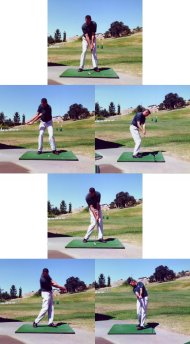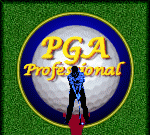Golf Instruction Article
|
|||||
|
After numerous "Ask the Pro" questions that were all about the same thing, a slice problem and how to cure it, I decided it was about
time to write a thorough article on this subject. But right here in green is the lightning fast, minimalist version for those who don't want to read the whole article. Curing the Slice
|
|
A simple slice equation (common version) A + B + C or D = S A The hands grip the club tightly and the arms initiate the downswing in an aggressive attempt to hit the ball hard + B The club immediately starts on a plane "above" or outside the ideal plane + C The club travels across the target line to the left through the ball, or + D The arms/club race past the body causing the heel to get to the ball before the toe (open face relative to swing path) = S SLICE |
Taking yet another step back, why is the club face open or why is the swing path to the left? HO! A proverbial "can of worms," say I! There could, in fact, be many reasons why the club face is open or why the swing path is going left:
- Improper hand position (grip)
- Improper hand action
- Improper arm action
- Improper weight shift or body movement
- Trying to hit the ball too hard
- Perhaps all of the above (more commonly referred to as "hacking")
In addition to the club face being open to the swing path it is also quite likely and perhaps more important that the club is traveling across the intended target line from outside-to-in (across to the left) through impact, exacerbating the side-spin problem. (See sidebar, "The Simple Slice Equation")
So, without going into detail about each of the things above (and without actually witnessing your golf swing) it is up to you to read the rest of this article, determine which of these problems you have, and do something about it. This sounds like an intriguing little project for you -- don't worry, I will give you some tools to help. (Or you can work with a reputable golf instruction professional in person.)
Knowing that the club face is open relative to the direction the club is traveling through impact we can start to make some adjustments. GREAT!
Relevant "Bird Walk"
A fairly logical, but at the same time hilarious, adjustment I frequently see is where the golf aspirant closes the club face drastically at address (to the tune of about 45 degrees closed and minus 35 degrees of loft), deducing that this will fix the slice problem. Note: Having the club face square at address is not the reason that the ball slices. As a matter of fact, starting with the face OPEN (to the right) at address might actually give you a better chance of slicing it LESS! As it turns out, sometimes the golfer's instinct for where the club face is pointing isn't too bad, and so starting with the club in an open position to the right (which you KNOW is going to make the ball go to the right) demands that one bring the face back more to the left, or closer to square, by feel in the downswing -- this exaggeration works in some cases to get the feeling of allowing the club to release.
End of Relevant "Bird Walk"
Anyway, the blame for all this incorrect action falls on lack of "feel."
- Lack of feel for what is going on in the swing
- Lack of feel for where the club face is pointing at any given moment (impact for instance)
- Lack of feel -- and even sight -- for the direction of the swing path through impact
- Lack of feel for allowing the club to "swing" rather than "hacking", "chopping", "hammering", "hitting", whatever you want to call it).
Feel ... is one of the biggest differences between a highly skilled player and an average player. So, where does this feel come from and how can you get some? Now we ARE getting somewhere.
The practice exercise I am about to describe to you will increase your feel for what is going on in the swing and through impact. It's pretty simple, but you must be willing to do this smoothly, without trying to hit the ball hard. You must be willing to work on it until you do, indeed, have the correct feel for the club face being square (or even closed) through impact and the swing path going out to the right. WARNING: If you try to hit the ball hard a number of things happen that make it impossible to learn the feeling I am talking about. Stick with the exercises at a very slow speed, making sure that you understand and have memorized the feeling of squaring the club face through impact. Once this feeling is ingrained speeding it up will be easy, but if you try it too fast too soon ... well, you can't get there from here. I warned you. All bets are off if you don't follow this advice.
 Go through this short range of motion to start. Click on the picture to enlarge it. Use your "Back" button to return. |
Start by doing all these things with a 5 or 6 iron (at least put the ball on a really good lie, but you can even tee it up a little bit -- this isn't about being good yet, it's about learning a feeling). You can advance to the longer clubs, including the driver, once you start to develop some feel. It might even be advisable to start with a partial range of motion instead of a full swing (e.g., hands about shoulder high, or less, on the backswing and likewise on the finish -- like in the photos).
Keep your hands fairly relaxed throughout the swing. This is the number one ingredient to developing feel. Keep reminding yourself to relax your hands and not squeeze the club to death. I'm not talking about having your hands so relaxed that the club is "sloppy" and moving around in your hands (but that is almost never a problem anyway). Let's just say I'd like for you to feel that the club is heavy -- sense the weight of the club head at the end of the shaft.
Now I want you to think about exaggerating in the opposite direction. Since, to create a slice, your club is traveling across to the left and/or facing open to the right of the swing path, let's try (remember, slowly and smoothly) swinging slightly out to the right and facing the club to the left. That is the opposite of what is causing the slice. Don't worry if you can't do this yet, and don't worry if you aren't hitting good shots (we're only swinging 10 miles an hour, how good could they be anyway?). The purpose here is just to learn a new feeling, not to hit good shots (yet). Think about this drill for a second. If you actually DID swing slightly out to the right and the club face was pointing slightly to the left through impact what would the result be? Well, on a short swing like we're starting with the ball should actually GO to the left. With a full swing you'd get a hook or a draw (stop salivating) because the spin is tilted counterclockwise (leaning to the left) with this swing path and face angle.
A few details: The most common problem associated with this is that many times the arms are the source of the downswing (hacking). Instead of pushing or pulling the club down at the ball with the arms and hands, just let the arms fall or drop, as you move your weight toward the left foot and turn your torso to the left and around toward the target. You don't need to take your eyes away from the ball to do this. Just feel what your body is doing. If you need to work on this without the ball for a while, or with the aid of a mirror, that's fine. Keep doing this slowly until you know the feeling of the club swinging from the inside of the target line and can even see the blur of the club's path through the bottom of your swing moving somewhat out to the right, or at the very least straight instead of left.
Every now and then come back to the impact position in extreme slow motion (so slow you can see the grooves on your club). Actually slow down and stop right behind the ball, seeing and feeling the position of the club face there, and seeing and feeling the path that the club head is on. Make sure you know the feeling of bringing it back square and on a path that might seem a bit out to the right.
These soft and slow motion drills will help you learn the feel of squaring the club and swinging more freely and on a better path, and eventually it will translate to your golf swing at normal speed. That merits reiteration: If you do these things they will eventually be doable in your full golf swing and you will have the necessary feel to square the face of the club through the ball.
![]()
If you need more help with your slice I could guarantee you a cure in just a few minutes working with you in person. If you're near the San Francisco bay area of Northern California, or if you'll be traveling this way, contact me for a private Golf School or a private lesson.
If working with me in person is not possible, this guy guarantees that his product will fix your slice.
* Actually it's the tilt of the spin or "spin axis" but it's easier to think of it as "sideways spin" like most people think of a sidearm curveball, even though that might not actually be what is happening

